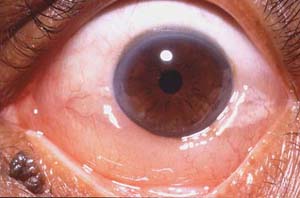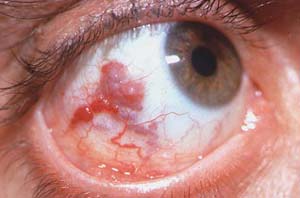|
|
 |
External Eye Photography
Films
William C. Nyberg, RBP CRA
Scheie Eye Institute
University of Pennsylvania

Chemosis of Conjunctiva
The use of conventional 35mm film in external eye photography is quickly becoming obsolete in favor of digital cameras which offer comprable image quality without the need for film processing or scanning for publication. However, many legacy systems are likely to exist for some time, and some photographers may simply prefer, for one reason or another, to work with film.
If film is used for external photography, daylight-balanced, color reversal (slide) films, with a sensitivity ("speed") of between ISO 25 and 100 are typically employed. These films usually respond to electronic flash with little or no color correction required. They offer superb color rendition and physical image structure (graininess and sharpness). Kodacrome film has been a favorite among plastic surgeons for its' particular rendition of flesh tones, but it is increasingly hard to find. The E-6 process ("Ektachrome") films are also excellent, and are more practical to have processed and duplicated. The differences in tone between the these two groups are subjective.

Hemangioma
|
 |
|